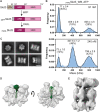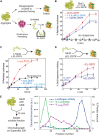Dodecamer assembly of a metazoan AAA+ chaperone couples substrate extraction to refolding
- PMID: 37163603
- PMCID: PMC10171807
- DOI: 10.1126/sciadv.adf5336
Dodecamer assembly of a metazoan AAA+ chaperone couples substrate extraction to refolding
Abstract
Ring-forming AAA+ chaperones solubilize protein aggregates and protect organisms from proteostatic stress. In metazoans, the AAA+ chaperone Skd3 in the mitochondrial intermembrane space (IMS) is critical for human health and efficiently refolds aggregated proteins, but its underlying mechanism is poorly understood. Here, we show that Skd3 harbors both disaggregase and protein refolding activities enabled by distinct assembly states. High-resolution structures of Skd3 hexamers in distinct conformations capture ratchet-like motions that mediate substrate extraction. Unlike previously described disaggregases, Skd3 hexamers further assemble into dodecameric cages in which solubilized substrate proteins can attain near-native states. Skd3 mutants defective in dodecamer assembly retain disaggregase activity but are impaired in client refolding, linking the disaggregase and refolding activities to the hexameric and dodecameric states of Skd3, respectively. We suggest that Skd3 is a combined disaggregase and foldase, and this property is particularly suited to meet the complex proteostatic demands in the mitochondrial IMS.
Figures







References
-
- Kim Y. E., Hipp M. S., Bracher A., Hayer-Hartl M., Hartl F. U., Molecular chaperone functions in protein folding and proteostasis. Annu. Rev. Biochem. 82, 323–355 (2013). - PubMed
-
- Hartl F. U., Protein misfolding diseases. Annu. Rev. Biochem. 86, 21–26 (2017). - PubMed
-
- Rosenzweig R., Nillegoda N. B., Mayer M. P., Bukau B., The Hsp70 chaperone network. Nat. Rev. Mol. Cell Biol. 20, 665–680 (2019). - PubMed
-
- Rampelt H., Mayer M. P., Bukau B., Nucleotide exchange factors for Hsp70 chaperones. Methods Mol. Biol. 1709, 179–188 (2018). - PubMed
MeSH terms
Substances
Grants and funding
LinkOut - more resources
Full Text Sources
Research Materials

